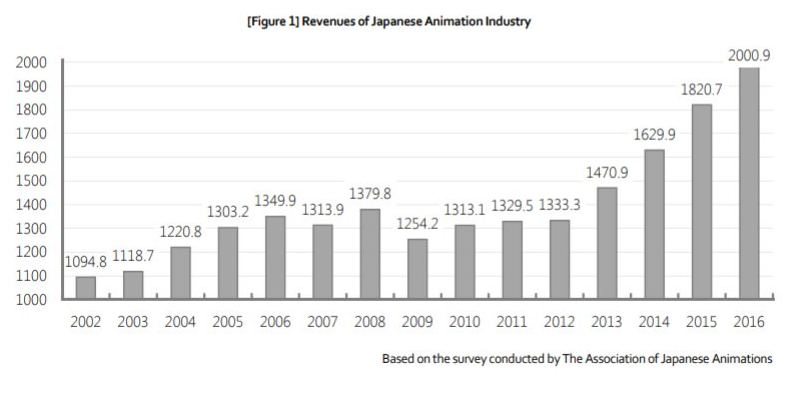Author: Gabriel Persechino-Forest Published: May 14th, 2018
Anime’s Rising Popularity
The market value of the anime industry in 2016 was about US17.5$ billions and was a result of a continued upward trend of around 10% every year since at least 2014. But because the increase is attributed to the overseas market, which means most sales goes to licensing management companies, it is believed that the benefits felt by this increase is minimal and as such the focus is still on the domestic market, which is unfortunately stagnating. It is not just the Western market that has helped drive this increase though but also the Chinese market; which has recently (2015) lifted the ban on Japanese theatrical features and began not only licensing but also investing in the Japanese market. The United-States used to be the country with the most contracts with the Japanese industry up until 2015; after which the new order became: China, South Korea, Taiwan and the United-States.
These reports are encouraging in that Western entities, at least for now, appear to have little impact on the production of anime both in terms of their contribution to the market’s growth and also due to rivalry with the Chinese market. However, as we’ve seen, they are not to be underestimated as they are indeed trying, through Amazon and Netflix, to shift this situation to one that will be more favorable to them. And while China offers an interesting new prospect, its government’s tendency towards random censorship leaves industry leaders with a need to be very careful to not rely on them. The stagnation of the home market is also of concern as Western entities continue to offer an “alternative” that is intentionally favoring their interests over the Japanese investors and fans.
Source: Association of Japanese Animations, Anime News Network (Article image as well)
Megalia
For starters, Anime Feminist unsurprisingly went in support of Nardack in the recent controversy concerning Azur Lane.
In other news, AFP BB News wrote a piece whose sole purpose was to claim that South Korean gamers are sexist and misogynistic. It further doubles down by claiming that South Korea’s patriarchal society prevents women from taking an active part in the creation of video games and was responsible for “rampant” harassment and sexism. To support its thesis, the article brings examples which often include talking about how attacks are made on Megalia; an extremist, radical misandrist group within the country whose nauseating, and many times illegal, behavior gets a free pass by Western establishment media. Those who dare to fight back and expose the scum for what they are end up characterised as “misogynists” and “angry sexist gamers”. Western news outlets either support the group or try the mitigate the damage as much as possible to lessen their crimes. Articles like this one which aim to reshape people’s view of the group’s illegal and immoral activities as “satirical” are common on how reporting is done on the organization; how quaint for them that whenever they say something repulsive, support a radical ideology or commit illegal acts, it is summed up as “satirical”.
Returning to the article, One Angry Gamer rightly points out that while the article attempts to paint sexism and Western trends as responsible for the South Korean gaming industry’s woes, the truth is the industry has itself been crippled by its own government’s heavy-handed, oppressive censorship.
Further reading:
Corporate Manipulations within Japanese Industry
